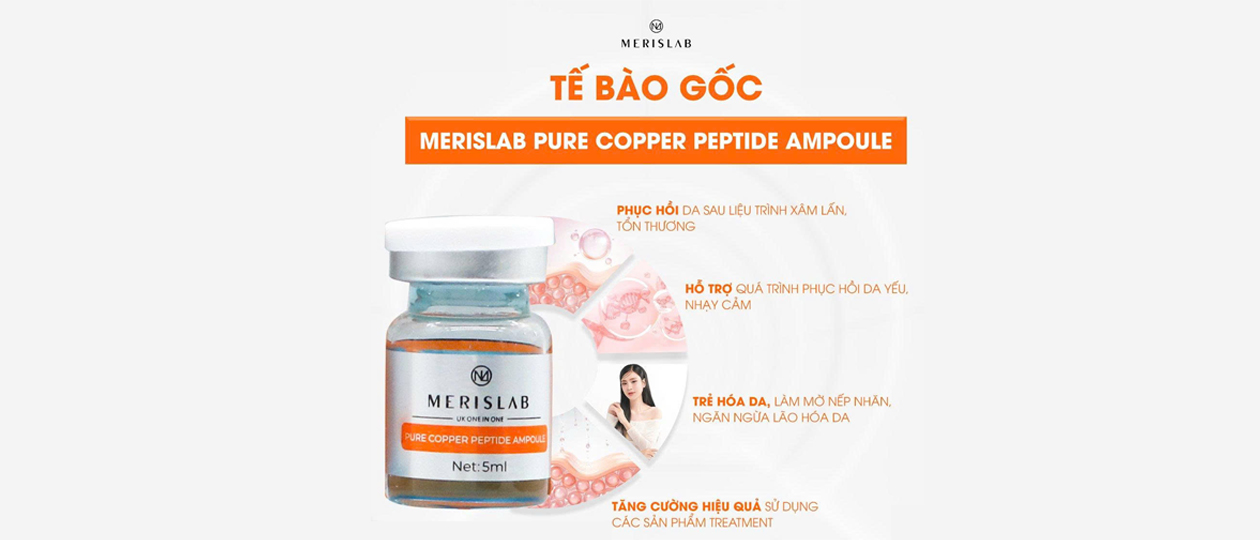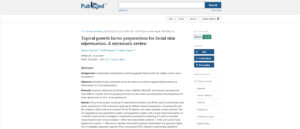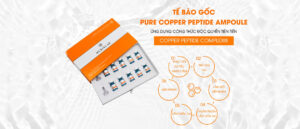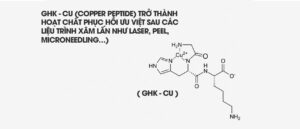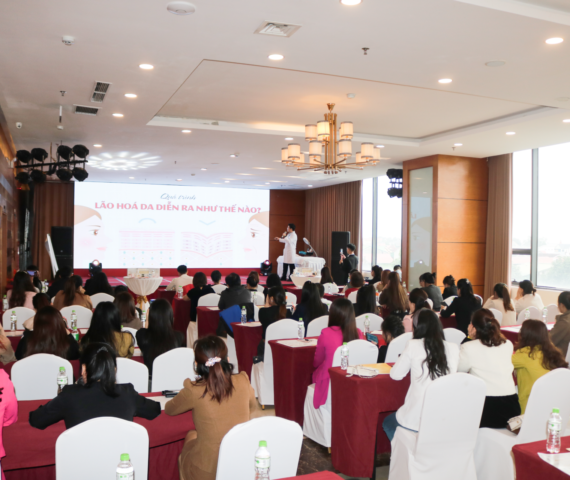Ngày 29.12.2023, hội thảo chuyên ngành thẩm mỹ với chủ đề cập nhật các xu hướng căng bóng, chống lão hóa, trẻ hóa, trị...
Khi nói đến các thành tựu khoa học đột phá trong lĩnh vực tái tạo và chống lão hóa da, Copper Peptide (GHK-Cu) đang được xem là hoạt chất tiên phong nhờ khả năng phục hồi tổn thương và trẻ hóa làn da vượt trội.
Sở hữu cơ chế hoạt động toàn diện, từ kích thích tổng hợp collagen, thúc đẩy tái cấu trúc nền ngoại bào đến kháng viêm và bảo vệ tế bào trước các gốc tự do, copper peptide đã được khẳng định qua nhiều nghiên cứu khoa học uy tín. Đặc biệt, công trình công bố trên tạp chí Aging Pathobiology and Therapeutics đã chứng minh rằng GHK-Cu không chỉ là một peptide thông thường mà còn là “chìa khóa vàng” giúp da duy trì trạng thái khỏe mạnh, ngăn ngừa lão hóa và hồi phục sau tổn thương. Sự ra đời của các sản phẩm tế bào gốc thế hệ mới như tế bào gốc – Merislab Pure Copper Peptide Ampoule đã hiện thực hóa tiềm năng đáng kinh ngạc này, mở ra kỷ nguyên mới trong điều trị và chăm sóc da chuyên sâu.
Nguồn gốc và cơ chế sinh học toàn diện của Copper Peptide
GHK-Cu (glycyl-L-histidyl-L-lysine copper complex) là một peptide tự nhiên hiện diện dồi dào trong huyết thanh của người trẻ khỏe mạnh, với nồng độ trung bình khoảng 200 ng/ml ở độ tuổi 20. Tuy nhiên, theo thời gian, hàm lượng này suy giảm mạnh, chỉ còn khoảng 80 ng/ml khi bước vào tuổi 60, làm suy yếu các quá trình tái tạo và sửa chữa tổn thương da. Điểm khác biệt lớn nhất của GHK là ái lực đặc biệt với ion đồng (Cu), giúp hình thành phức hợp GHK-Cu có hoạt tính sinh học mạnh mẽ.
> Phức hợp này hoạt động như một công tắc sinh học đa chức năng:
> Kích hoạt sản xuất collagen type I & III và elastin – các thành phần chính tạo nên độ săn chắc, đàn hồi của da.
> Thúc đẩy quá trình tổng hợp glycosaminoglycan, acid hyaluronic nội sinh, cải thiện độ ẩm nền và củng cố hàng rào bảo vệ da.
> Tăng tốc lành thương nhờ điều hòa tăng sinh nguyên bào sợi và kích hoạt các enzyme tái cấu trúc mô liên kết.
> Giảm hoạt động của metalloproteinase (MMPs) – enzym phá hủy collagen, giúp duy trì kết cấu da bền vững trước tác động của tuổi tác.
Chính cơ chế đa chiều này đã khiến GHK-Cu được xem là hoạt chất then chốt trong các phác đồ trẻ hóa da và phục hồi tổn thương hiện đại.
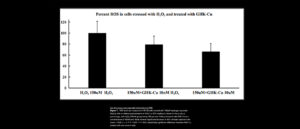
Các nhóm thử nghiệm:
H₂O₂ 150µM (cột 1): Nhóm chỉ bị stress oxy hóa, ROS đạt 100%.
H₂O₂ + GHK-Cu 10nM (cột 2): Giảm nhẹ ROS (~80%).
H₂O₂ + GHK-Cu 10µM (cột 3): Giảm mạnh ROS (~60%).
Khi xử lý bằng GHK-Cu trước khi stress oxy hóa, mức ROS giảm đáng kể theo liều lượng.
Nhóm GHK-Cu 10µM cho kết quả ức chế ROS tốt nhất.
Kết luận → GHK-Cu có khả năng chống oxy hóa mạnh, bảo vệ tế bào khỏi tổn thương do gốc tự do – một cơ chế then chốt trong lão hóa da)
Tác dụng chống lão hóa, kháng viêm và đẩy nhanh tái tạo mô tổn thương
Nghiên cứu được đăng trên Aging Pathobiology and Therapeutics không chỉ nhấn mạnh vai trò làm đẹp của GHK-Cu mà còn chỉ rõ những tác động sinh học sâu rộng. Các thí nghiệm in vitro (trong ống nghiệm) và in vivo (trên mô sống) đã cho thấy GHK-Cu có khả năng ức chế phản ứng viêm và giảm stress oxy hóa – hai cơ chế trung tâm thúc đẩy lão hóa và phá hủy cấu trúc nền da.
Đặc biệt, phức hợp GHK-Cu còn chứng minh:
> Hiệu quả làm mờ nếp nhăn nông và cải thiện độ dày của lớp trung bì, nhờ kích thích nguyên bào sợi tăng tổng hợp protein nền.
> Giảm rõ rệt hiện tượng tăng sắc tố hậu viêm, nhờ khả năng điều hòa hoạt động melanocyte và hỗ trợ sửa chữa DNA của tế bào.
> Thúc đẩy tái biểu mô hóa (re-epithelialization) giúp các vết thương liền nhanh hơn, đồng thời giảm nguy cơ hình thành sẹo xơ cứng.
> Bảo vệ tế bào trước tác động tiêu cực của tia UV và các gốc tự do – nguyên nhân hàng đầu gây thoái hóa collagen và elastin.
Nhờ đó, Copper Peptide trở thành lựa chọn ưu việt không chỉ trong điều trị lão hóa mà còn phục hồi sau peel, laser và các liệu trình xâm lấn chuyên sâu.
Ứng dụng Copper Peptide Complex® trong Merislab Pure Copper Peptide Ampoule
Hiểu rõ tiềm năng đột phá của copper peptide, Merislab đã phát triển dòng tế bào gốc thế hệ mới – Merislab Pure Copper Peptide Ampoule – tích hợp công thức Copper Peptide Complex® độc quyền.
Sản phẩm kết hợp tối ưu các thành phần:
Copper Peptide (GHK-Cu): Kích hoạt tổng hợp collagen – elastin, tái cấu trúc nền ngoại bào, làm đầy nếp nhăn li ti và phục hồi sức sống tế bào.
EGF (Epidermal Growth Factor): Thúc đẩy tăng trưởng tế bào mới, rút ngắn thời gian tái tạo biểu bì, củng cố độ dày da.
Sodium Hyaluronic Acid: Cấp ẩm sâu, duy trì trạng thái căng mọng và mềm mượt tức thì.
Chiết xuất Tremella Fuciformis Mushroom (nấm tuyết): Giàu polysaccharides và vitamin, giúp chống oxy hóa mạnh và hỗ trợ làm sáng da.
Nhờ sự kết hợp này, sản phẩm trở thành giải pháp toàn diện:
Hỗ trợ phục hồi da nhạy cảm, tổn thương sau trị liệu.
Ngăn ngừa hình thành nếp nhăn, cải thiện độ đàn hồi.
Duy trì trạng thái cân bằng và khỏe mạnh lâu dài cho làn da.
Đây chính là bước đột phá quan trọng giúp khách hàng nhanh chóng sở hữu làn da tái sinh – mịn màng và trẻ trung vượt thời gian.
Copper Peptide đã và đang trở thành lựa chọn vàng trong phác đồ chăm sóc da sau treatment, trị liệu chuyên sâu. Merislab Pure Copper Peptide Ampoule không chỉ đại diện cho xu hướng công nghệ peptide thế hệ mới, mà còn là bệ phóng lý tưởng để tái sinh làn da khỏe mạnh, căng bóng và tươi trẻ bền vững. Việc ứng dụng Copper Peptide vào quy trình chăm sóc da cá nhân hóa sẽ mở ra cơ hội mới giúp khách hàng đón nhận một diện mạo trẻ trung và tràn đầy sức sống.
—-
TÀI LIỆU THAM KHẢO
Pickart L, Thayer L, Thaler MM. A synthetic tripeptide which increases survival of normal liver cells, and stimulates growth in hepatoma cells. Biochemical and biophysical research communications, 1973, 54(2): 562–566. – PubMed
Lane TF, Iruela-Arispe ML, Johnson RS, et al. SPARC is a source of copper-binding peptides that stimulate angiogenesis. The Journal of cell biology, 1994, 125(4): 929–943. – PMC – PubMed
Pickart L The human tri-peptide GHK and tissue remodeling. Journal of Biomaterials Science, Polymer Edition, 2008, 19(8): 969–988. – PubMed
Pollard JD, Quan S, Kang T, et al. Effects of copper tripeptide on the growth and expression of growth factors by normal and irradiated fibroblasts. Archives of facial plastic surgery, 2005, 7(1): 27–31. – PubMed
Steiling H, Werner S. Fibroblast growth factors: key players in epithelial morphogenesis, repair and cytoprotection. Current opinion in biotechnology, 2003, 14(5): 533–537. – PubMed
Powers CJ, McLeskey SW, Wellstein A. Fibroblast growth factors, their receptors and signaling. Endocrine-related cancer, 2000, 7(3): 165–197. – PubMed
Wang X, Liu B, Xu Q, et al. GHK-Cu-liposomes accelerate scald wound healing in mice by promoting cell proliferation and angiogenesis. Wound Repair and Regeneration, 2017, 25(2): 270–278. – PubMed
Raju KS, Alessandri G, Gullino PM. Characterization of a chemoattractant for endothelium induced by angiogenesis effectors. Cancer research, 1984, 44(4): 1579–1584. – PubMed
Poole TJ, Zetter BR. Stimulation of rat peritoneal mast cell migration by tumor-derived peptides. Cancer research, 1983, 43(12 Part 1): 5857–5861. – PubMed
Maquart FX, Bellon G, Chaqour B, et al. In vivo stimulation of connective tissue accumulation by the tripeptide-copper complex glycyl-L-histidyl-L-lysine-Cu2+ in rat experimental wounds. The Journal of clinical investigation, 1993, 92(5): 2368–2376. – PMC – PubMed
Siegel RC, Pinnell SR, Martin GR. Cross-linking of collagen and elastin. Properties of lysyl oxidase. Biochemistry, 1970, 9(23): 4486–4492. – PubMed
Siméon A, Monier F, Emonard H, et al. Expression and activation of matrix metalloproteinases in wounds: modulation by the tripeptide–copper complex glycyl-L-histidyl-L-lysine-Cu2+. Journal of investigative dermatology, 1999, 112(6): 957–964. – PubMed
Siméon A, Wegrowski Y, Bontemps Y, et al. Expression of glycosaminoglycans and small proteoglycans in wounds: modulation by the tripeptide–copper complex glycyl-l-histidyl-l-lysine-Cu2+. Journal of Investigative Dermatology, 2000, 115(6): 962–968. – PubMed
Pohunkova H, Stehí J, Vachal J, et al. Morphological features of bone healing under the effect of collagen-graft—glycosaminoglycan copolymer supplemented with the tripeptide Gly-His-Lys. Biomaterials, 1996, 17(16): 1567–1574. – PubMed
Godet D, Marie PJ. Effects of the tripeptide glycyl-L-histidyl-L-lysine copper complex on osteoblastic cell spreading, attachment and phenotype. Cellular and molecular biology (Noisy-le-Grand, France), 1995, 41(8): 1081–1091. – PubMed
Fu SC, Cheuk YC, Chiu WYV, et al. Tripeptide–copper complex GHK-Cu (II) transiently improved healing outcome in a rat model of ACL reconstruction. Journal of Orthopaedic Research, 2015, 33(7): 1024–1033. – PubMed
Pickart L, Vasquez-Soltero JM, Margolina A. GHK peptide as a natural modulator of multiple cellular pathways in skin regeneration. BioMed research international, 2015, 2015. – PMC – PubMed
Beretta G, Artali R, Regazzoni L, et al. Glycyl-histidyl-lysine (GHK) is a quencher of α, β-4-hydroxy-trans-2-nonenal: a comparison with carnosine. Insights into the mechanism of reaction by electrospray ionization mass spectrometry, 1H NMR, and computational techniques. Chemical research in toxicology, 2007, 20(9): 1309–1314. – PubMed
Beretta G, Arlandini E, Artali R, et al. Acrolein sequestering ability of the endogenous tripeptide glycyl-histidyl-lysine (GHK): characterization of conjugation products by ESI-MSn and theoretical calculations. Journal of pharmaceutical and biomedical analysis, 2008, 47(3): 596–602. – PubMed
Sakuma S, Ishimura M, Yuba Y, et al. The peptide glycyl-l-histidyl-l-lysine is an endogenous antioxidant in living organisms, possibly by diminishing hydroxyl and peroxyl radicals. International journal of physiology, pathophysiology and pharmacology, 2018, 10(3): 132. – PMC – PubMed
Zhou XM, Wang GL, Wang XB, et al. GHK peptide inhibits bleomycin-induced pulmonary fibrosis in mice by suppressing TGFβ1/Smad-mediated epithelial-to-mesenchymal transition. Frontiers in Pharmacology, 2017, 8: 904. – PMC – PubMed
Park JR, Lee H, Kim SI, et al. The tri-peptide GHK-Cu complex ameliorates lipopolysaccharide-induced acute lung injury in mice. Oncotarget, 2016, 7(36): 58405. – PMC – PubMed
Gao M, Chen L, Yu H, et al. Diosgenin down-regulates NF-κB p65/p50 and p38MAPK pathways and attenuates acute lung injury induced by lipopolysaccharide in mice. International immunopharmacology, 2013, 15(2): 240–245. – PubMed
Liu T, Zhang L, Joo D, et al. NF-κB signaling in inflammation. Signal transduction and targeted therapy, 2017, 2(1): 1–9. – PMC – PubMed
Kaminska B MAPK signalling pathways as molecular targets for anti-inflammatory therapy—from molecular mechanisms to therapeutic benefits. Biochimica et Biophysica Acta (BBA)-Proteins and Proteomics, 2005, 1754(1–2): 253–262. – PubMed
Yong HY, Koh MS, Moon A. The p38 MAPK inhibitors for the treatment of inflammatory diseases and cancer. Expert opinion on investigational drugs, 2009, 18(12): 1893–1905. – PubMed
Mukherjee K, Lee A, Zhu L, et al. Sleep-deprived cognitive impairment in aging mice is alleviated by rapamycin. Aging Pathobiology and Therapeutics, 2019, 1(1): 05–09. – PMC – PubMed
Gould L, Abadir P, Brem H, et al. Chronic wound repair and healing in older adults: current status and future research. Wound Repair and Regeneration, 2015, 23(1): 1–13. – PMC – PubMed
Davalli P, Mitic T, Caporali A, et al. ROS, cell senescence, and novel molecular mechanisms in aging and age-related diseases. Oxidative medicine and cellular longevity, 2016, 2016. – PMC – PubMed
